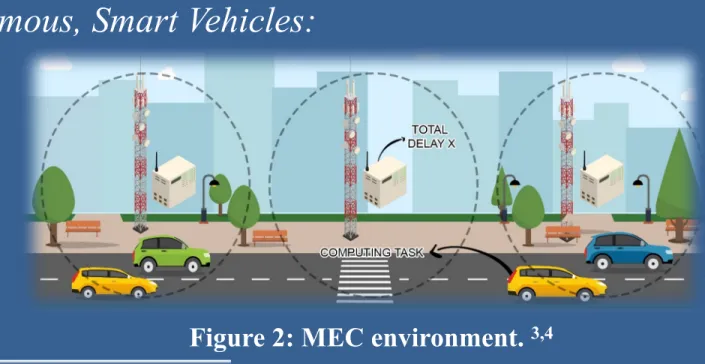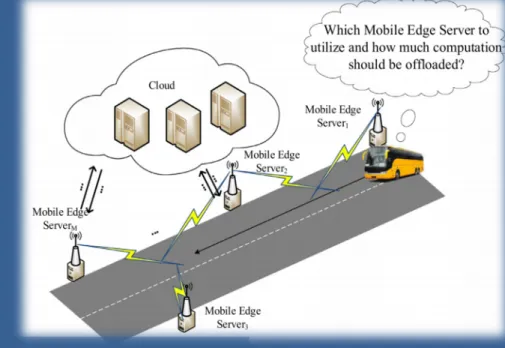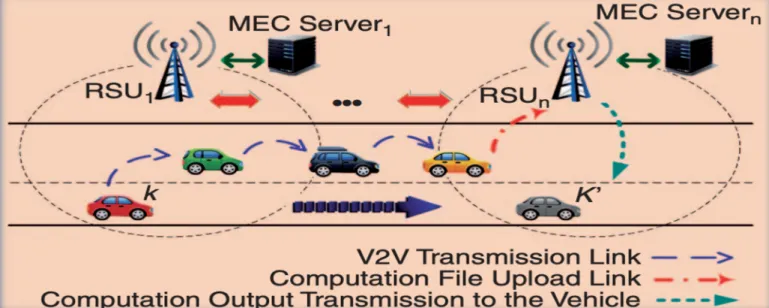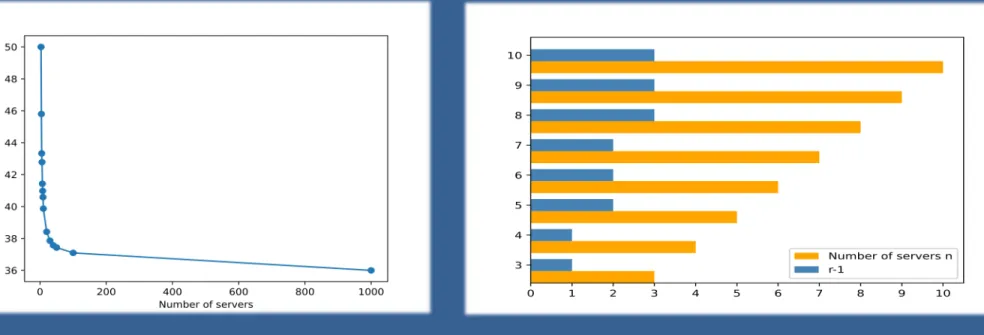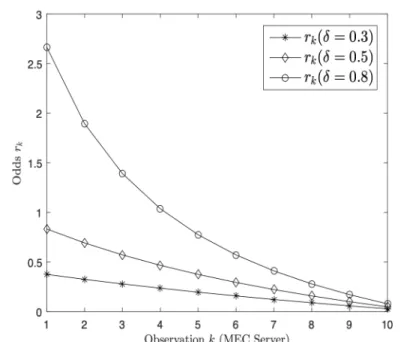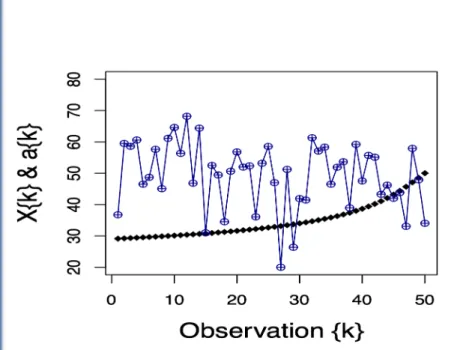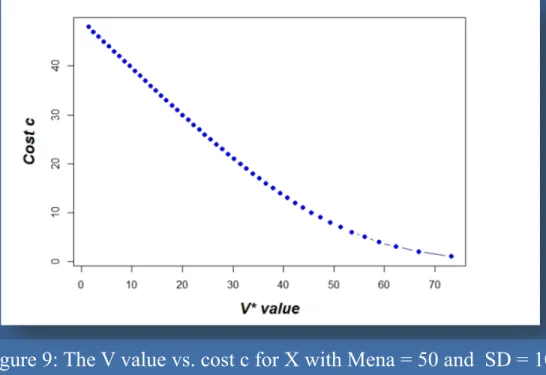Task offloading in Mobile Edge Computing: An Optimal Stopping
Theory approach
Essence Lab Talk, Thursday 4 March 2021 Ibrahim Alghamdi
Distributed Intelligence
Ibrahim Alghamdi, Essence Lab Talk, 4 March 2021 [University of Glasgow]
Outline
• Introduction
§ Background
§ Motivation & Challenge
§ Related work and contribution
• Task offloading decision making
§ System Model
§ Problem Formulation
§ Maximizing the Probability of Offloading to the Best Server
§ Minimizing the Expected Total Delay of Task Offloading
• Performance evaluation
§ Simulation
§ Real data set evaluation
§ Real implementation
• Future work
2
New forms of mobile nodes
Ibrahim Alghamdi, Essence Lab Talk, 4 March 2021 [University of Glasgow]
The Requirements of the Emerging Applications
• Require higher computing/networking resources:
– Latency-sensitive applications (virtual reality)
– Powerful CPUs (data analytics using machine learning) – Need more storages (sensing and collecting data)
• These requirements contradict with the mobile nodes capabilities.
4
Computation offloading
• Sending the computing task to an external server.
• The Cloud was the initial place for offloading.
• The Mobile cloud computing.
• Higher cost;
– More delay.
– More load on the network.
Ibrahim Alghamdi, Essence Lab Talk, 4 March 2021 [University of Glasgow]
From the Cloud to the Edge
• Move the Cloud resources closer to the user.
• There different names in the literature:
– edge computing.
– cloudlet.
– fog computing.
• Mobile Edge Computing.
6
Motivation
• The deployment of MEC servers. 1
• MEC servers’ load have large variation. 2
1M. Patel, B. Naughton, C. Chan, N. Sprecher, S. Abeta, A. Neal et al., “Mobile-edge computing introductory technical white paper,” White Paper, Mobile-edge Computing (MEC) industry initiative, 2014.
2 C. N. Le Tan, C. Klein, and E. Elmroth, “Location-aware load prediction in edge data centers,” in 2nd FMEC. IEEE, 2017, pp. 25–31.
Figure 1: Workload in 37 EDCs
according to the simulation in 2
Ibrahim Alghamdi, Essence Lab Talk, 4 March 2021 [University of Glasgow]
Motivation Example: MEC in RSU
• Autonomous, Smart Vehicles:
3 K. Zhang, Y. Mao, S. Leng, Y. He, and Y. Zhang, “Mobile-edge computing for vehicular networks: A promising network paradigm with predictive off-loading,”IEEE Vehicular Technology Magazine, vol. 12,no. 2, pp. 36–44, 2017.
4 R. Akmam Dziyauddin, D. Niyato, N. Cong Luong, M. A. M. Izhar,M. Hadhari, and S. Daud, “Computation offloading and content caching delivery in vehicular edge computing: A survey,”arXiv, pp. arXiv–1912,2019.
8
Figure 2: MEC environment. 3,4
Naïve Approach
5W. Tang, X. Zhao, W. Rafique, L. Qi, W. Dou, and Q. Ni, “An offloading method using decentralized p2p-enabled mobile edge servers in edgecomputing,”Journal of Systems Architecture, vol. 94, pp. 1–13, 2019.
6K. Zhang, Y. Zhu, S. Leng, Y. He, S. Maharjan, and Y. Zhang, “Deep learning empowered task offloading for mobile edge computing in urban informatics,”IEEE Internet ofThings Journal, vol. 6, no. 5, pp. 7635–7647, 2019
Figure 3: Centralised offloading. 5,6
Ibrahim Alghamdi, Essence Lab Talk, 4 March 2021 [University of Glasgow]
Figure 4: V2V offloading method. 3
V2V Approach
3 K. Zhang, Y. Mao, S. Leng, Y. He, and Y. Zhang, “Mobile-edge computing for vehicular networks: A promising network paradigm with predictive off-loading,”IEEE Vehicular Technology Magazine, vol. 12,no. 2, pp. 36–44, 2017.
10
Contributions
• Offloading decision.
– Independent
• Considerations:
– Mobility:
• Higher chance of meeting better resources.
7– Deadline:
• We must offload before T.
5– Sequential:
• Optimality found in the optimal stopping theory
7 S. Zhou, Y. Sun, Z. Jiang, and Z. Niu, “Exploiting moving intelligence: Delay-optimized computation offloading in vehicular fog networks,”IEEE Communications Magazine, vol. 57, no. 5, pp. 49–55, 2019.
5 W. Tang, X. Zhao, W. Rafique, L. Qi, W. Dou, and Q. Ni, “An offloading method using decentralized p2p-enabled mobile edge servers in edgecomputing,”Journal of Systems Architecture, vol. 94, pp. 1–13, 2019.
Task offloading decision-making
- System Model
- Problem formulation - The proposed models
SchoolofComputing Science Essence: Pervasive &
Distributed Intelligence
Setting/system model 3
• MEC servers deployed along the user path.
• Mobile node moves in 1D mobility model.
• Computing task to be offloaded to one of the MEC servers.
• The mobile node only knows about the current MEC (the one in the range of mobile node).
• Processing time X.
3 K. Zhang, Y. Mao, S. Leng, Y. He, and Y. Zhang, “Mobile-edge computing for vehicular networks: A promising network paradigm with predictive off- loading,” IEEE Vehicular Technology Magazine, vol. 12, no. 2, pp. 36–44, 2017.
Figure 5: Context
Ibrahim Alghamdi, Essence Lab Talk, 4 March 2021 [University of Glasgow]
Problem Statement (1)
• A key problem:
– Deciding which server to select?
• Giving
– we have load variance for edge servers over time,
– users are moving, and knows only about the server in the range of it.
• Applying the Optimal Stopping Theory
14
Problem Statement (2)
Objective 1: Maximizing the Probability of Offloading to the Best Server.
Objective 2: Minimizing the Expected Execution Time when Offloading.
Specifically: find an offloading rules that achieve the previous
two objectives.
Ibrahim Alghamdi, Essence Lab Talk, 4 March 2021 [University of Glasgow]
Maximizing the Probability of Offloading to the Best Server (1)
• Goal:
– Max (𝑃 ! ∗ )
• Assumption:
– We know the number of options servers/times.
– No recall is allowed.
• This is cast as a Best-Choice Problem (BCP) 8 .
8T. S. Ferguson, “Optimal Stopping and Applications,” http://www.math.ucla.edu/ tom/Stopping/Contents.html, March 2019.
16
The Offloading Rule
• Let M be the best server among 𝑟 ! -1 servers.
• Based on the BCP, the optimal offloading policy is to
– reject the first 𝑟 ! − 1 servers (times).
– offload first server that is better than M.
• 𝑟 ! = min{r ≥ 1: "
# + "
#$" +…+ !%" " ≤1} for n ≥ 2 ..(1)
• 𝑃 ∗ (𝑟 ! ) = # ! ! %" ∑ '(# ! ! "
'%" ...(2)
• In the case where there is a relatively high number of servers, r=n/e and the probability is around 0.368. 8
8T. S. Ferguson, “Optimal Stopping and Applications,” http://www.math.ucla.edu/ tom/Stopping/Contents.html, March 2019.
Ibrahim Alghamdi, Essence Lab Talk, 4 March 2021 [University of Glasgow]
Cont’d
8T. S. Ferguson, “Optimal Stopping and Applications,” http://www.math.ucla.edu/ tom/Stopping/Contents.html, March 2019.
Figure 6: The probability of offloading to the best (left) and the value of r−1(right) for different numbers of MEC servers n.
18
to the Best Server (2)
• Goal:
– Max (𝑃 " ∗ )
• Assumption:
– We know the probability distribution function of X.
• MEC server operator
• historical data
– Data quality indicator:
• 𝑓
!= %1 −
!
"#$
, 1 ≤ 𝑘 < 𝑛 0, 𝑘 ≥ 𝑛
• 1 is fresh (when k=0), 0 is very old data (when k=n)
– No recall is allowed.
• Odd-sum model
9.
9F. T. Bruss, “Sum the odds to one and stop,” Annals of Probability, pp. 1384–1391, 2000.
.
Ibrahim Alghamdi, Essence Lab Talk, 4 March 2021 [University of Glasgow]
Odds Algorithm
• Odds algorithm:
– maximise the probability of stopping at the last success.
• Offload to MEC server with specific threshold.
– For example, the mobile node needs processing time less than 50 ms.
• The Odds in general:
– 𝑟 $ = &' % %
%%
• The Odds in our case:
– 𝑟 $ = (&' % %
%(
%%
)(
%20
Figure 7: The odds against observation.
So what are the offloading rules now?
• The Odds-algorithm sums up the Odds in reverse order:
– 𝒓
𝒏+𝒓
𝒏"𝟏+ 𝒓
𝒏"𝟐+ ⋯ + 𝒓
𝒔• Let us denote that this happens at observation s:
– 𝑹 𝒔 = 𝒓 𝒏 +𝒓 𝒏'𝟏 + 𝒓 𝒏'𝟐 + ⋯ + 𝒓 𝒔
• Example:
– s = 4 in the – s =1
• The offloading rule:
– reject all observation before s
– After s, start looking for the server that meets the requirements.
Figure 7: The odds against observation.
Ibrahim Alghamdi, Essence Lab Talk, 4 March 2021 [University of Glasgow]
Minimising the Expected Processing Time (1)
• Delay-Tolerant Sequential Decision Making (DTO)
• Assumption:
– We have an idea about the the load (execution time) of the MEC servers, i.e. X.
– We know the number of options servers/times.
• Finite Horizon Optimal Stopping Problem
22
Cont’d
• Find the optimal stopping time:
– 𝑘 = inf{𝑘: 𝑋 / < 𝔼 𝑋 /01 }
• At each observation take the minimum between:
– current processing time
– or the expected processing time in the next time
• We provide an estimate of the optimal offloading time.
• The optimal offloading time is determined by the values 𝑎 ( , 𝑎 ) ,…, 𝑎 * by
which the mobile node decides either to offload or not.
Ibrahim Alghamdi, Essence Lab Talk, 4 March 2021 [University of Glasgow]
• The values of the threshold a is calculated through the backward indication starting from the last observation.
Cont’d
24
• The decision values (black points).
• Simulated server processing time (blue points) vs.
• The optimal data
offloading time when k=
27,29,46,47,48and 50 where X < a.
• We offload at k=27
Cont’d
Figure 8:The decision values a and X vs observation k
Ibrahim Alghamdi, Essence Lab Talk, 4 March 2021 [University of Glasgow]
• Cost-based Optimal Task Offloading Policy (COT)
• Goal:
– We desire to find when to offload and which server that minimizes the total expected cost.
• Assumption:
– We have an idea about the the load of the MEC servers, i.e. X.
– The mobile node pays c cost units per observation when it has not yet offloaded the task/data.
𝒀 = 𝑿 + 𝒄𝒌
Minimising the Expected Processing Time (2)
26
𝑌 = 𝑋 + 𝑐𝑘…(1)
• The node minimizes the expected cost Y by offloading at the first server such that:
𝑘 ∗ = min{𝑘 > 0: 𝑋 , ≤ 𝑉 ∗ }…(2) where the 𝑉 ∗ is the solution of:
∫ - . ∗ 𝑥 − 𝑉 ∗ 𝑑𝐹 𝑥 = 𝑐…(3)
• where F(x) is the CDF of X.
Cont’d
Ibrahim Alghamdi, Essence Lab Talk, 4 March 2021 [University of Glasgow]
Cont’d
28
Figure 9: The V value vs. cost c for X with Mena = 50 and SD = 10.
BCP Odds
DTO COT
Figure 10: Summary of the OST based model.
Performance Evaluation
• Simulation Based
• Real data set
• Real implementation
SchoolofComputing Science Essence: Pervasive &
Distributed Intelligence
Performance Assessment
• Approaches:
– Simulation Based – Real data set
– Real implementation
• Comparison:
– Best Choice Problem (BCP) – Odds
– Delay-Tolerant Sequential Decision-making (DTO) – COT
– Random.
– p-model with different probability p=0.8
– The optimal.
Ibrahim Alghamdi, Essence Lab Talk, 4 March 2021 [University of Glasgow]
Performance Evaluation (1): Simulation 32
Figure 11: Simulation results for normally distributed processing time.
Figure 12: Simulation results for uniformly distributed processing time.
Ibrahim Alghamdi, Essence Lab Talk, 4 March 2021 [University of Glasgow]
Performance Evaluation (2): data set
• We used the real dataset of taxi cabs’
movements in Rome 1 .
• Real Server utilisation 2
1 L.Bracciale,M.Bonola,P.Loreti,G.Bianchi,R.Amici,andA.Rabuffi, “CRAWDAD dataset roma/taxi (v. 2014-07-17),” Downloaded from https://crawdad.org/roma/taxi/20140717, Jul. 2014.
2 https://github.com/alibaba/clusterdata/blob/master/cluster-trace-v2018/trace_2018.md

